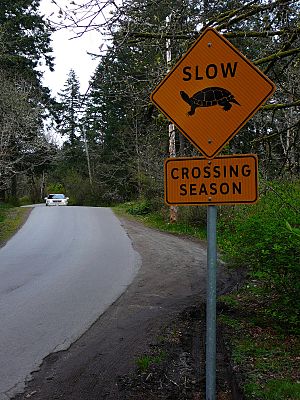Conservation of painted turtles facts for kids
The painted turtle is a common turtle found across North America. Unlike some animals that have lost most of their original homes, painted turtles still live in many of the same places they always have. Scientists have known since at least 1952 that people are affecting these turtles.
Even though painted turtles are widespread, their numbers are likely lower than they used to be. This is because humans have built more cities and towns. Painted turtles are quite tough. They can survive in places changed by people, like polluted wetlands or man-made ponds. They also have many babies, which helps them keep their populations strong. In some areas, like New England, fertilizer runoff has even created overgrown lakes that painted turtles love!
However, in some parts of the Pacific Northwest, like Oregon and British Columbia, the painted turtle's numbers are shrinking. In Oregon, the turtle is considered "imperiled," meaning it's in danger. In British Columbia, coastal painted turtles are endangered, and others are "of special concern." People in British Columbia really want to protect these turtles because they have already lost all their other native turtle species. Despite efforts, only a few thousand painted turtles remain in that province. Many things can harm painted turtles, but it's hard to know exactly how much each factor affects them.
Contents
Why Are Painted Turtles in Danger?
Losing Their Homes
One big problem for painted turtles is losing their homes. Wetlands, which are wet, marshy areas, are often dried up for building. Even if water remains, turtles need logs and rocks to warm up in the sun. If these are removed, turtles lose their basking spots.
Clearing plants along the water's edge also makes it easier for predators to find turtles. More people walking around can also scare turtles away from their sunny spots. Away from the water, building new areas or planting too many trees can remove the open, sunny soil turtles need to lay their eggs.
Road Dangers
Another major threat is roadkill. This happens when turtles are hit by cars. You can often see dead turtles on roads during summer. In 1974, a scientist counted 14 dead turtles on just one short road in Pennsylvania in a single day! More cars and roads built through turtle habitats have made this problem worse over time.
A study in Montana found far fewer turtles near a busy highway than in areas a few miles away. The turtles near the road were also much younger. This suggests that roads are killing many turtles. It also means that new turtles have to come from areas far from the road to keep those populations going.
Surveys near busy roads often show more male turtles than females. This means that most turtles killed on roads are likely nesting females. Males can often find water routes to move around, but females have to come onto land to lay their eggs. Roads can also separate groups of turtles, making it harder for them to find mates and keep their genes healthy.
People are trying different ways to help turtles cross roads safely. In Portland, Oregon, an underpass was built for turtles, and they have learned to use it. Montana is building highway barriers to keep turtles off busy roads. Simpler solutions include "turtle crossing" signs and teaching drivers to watch out for turtles. If it's safe, you can even help a turtle cross the road in the direction it's already heading.
New Animals in Their Homes
When new animals are brought into an area where they don't naturally live, it can harm painted turtles. Red-eared sliders are a common pet turtle. Many have been released or escaped and now live in the wild, even in Canada. They are similar in size and habits to painted turtles, so they might compete for food and space. However, we don't know for sure how much they affect painted turtles.
In the western United States, some predators that eat young painted turtles have been introduced. These include bass fish, snapping turtles, and bullfrogs. Studies show that bullfrogs and bass don't eat many painted turtles. Snapping turtles might have a bigger impact, and in Oregon, people have even trapped them to remove them from turtle habitats.
In cities, there are more animals like raccoons, foxes, and coyotes that eat turtle eggs. Stray dogs and cats can also harm turtles. Some cities have tried putting fences around turtle nests to protect the eggs from predators.
Other Concerns for Turtles
Taking painted turtles from the wild or releasing pet turtles can both cause problems. If too many turtles are taken from an area to be sold as pets, the local population can shrink quickly. Releasing pet turtles can also spread diseases like salmonella or introduce turtles with weaker genes into wild groups.
Pollution can also be a danger. Pesticides used to kill mosquitoes might harm the insects that turtles eat. Herbicides used to kill weeds can hurt the plants turtles rely on. General water pollution can also affect turtles, but scientists haven't measured exactly how much.
Outdoor activities can also impact turtles. Boats near basking spots can disturb turtles trying to warm up. Some turtles accidentally get caught on fishing hooks. Turtles are known for stealing bait!
Even turtle research can sometimes affect turtle populations. Some scientists suggest using computer models to study turtle numbers instead of always catching and releasing them.
Similar to road deaths, farm machinery can kill female turtles and destroy nests. Lawnmowers, especially on golf courses, can also kill turtles. Riding all-terrain vehicles (ATVs) carelessly can also harm turtles. Finally, global warming is a future threat that scientists are still trying to understand.


